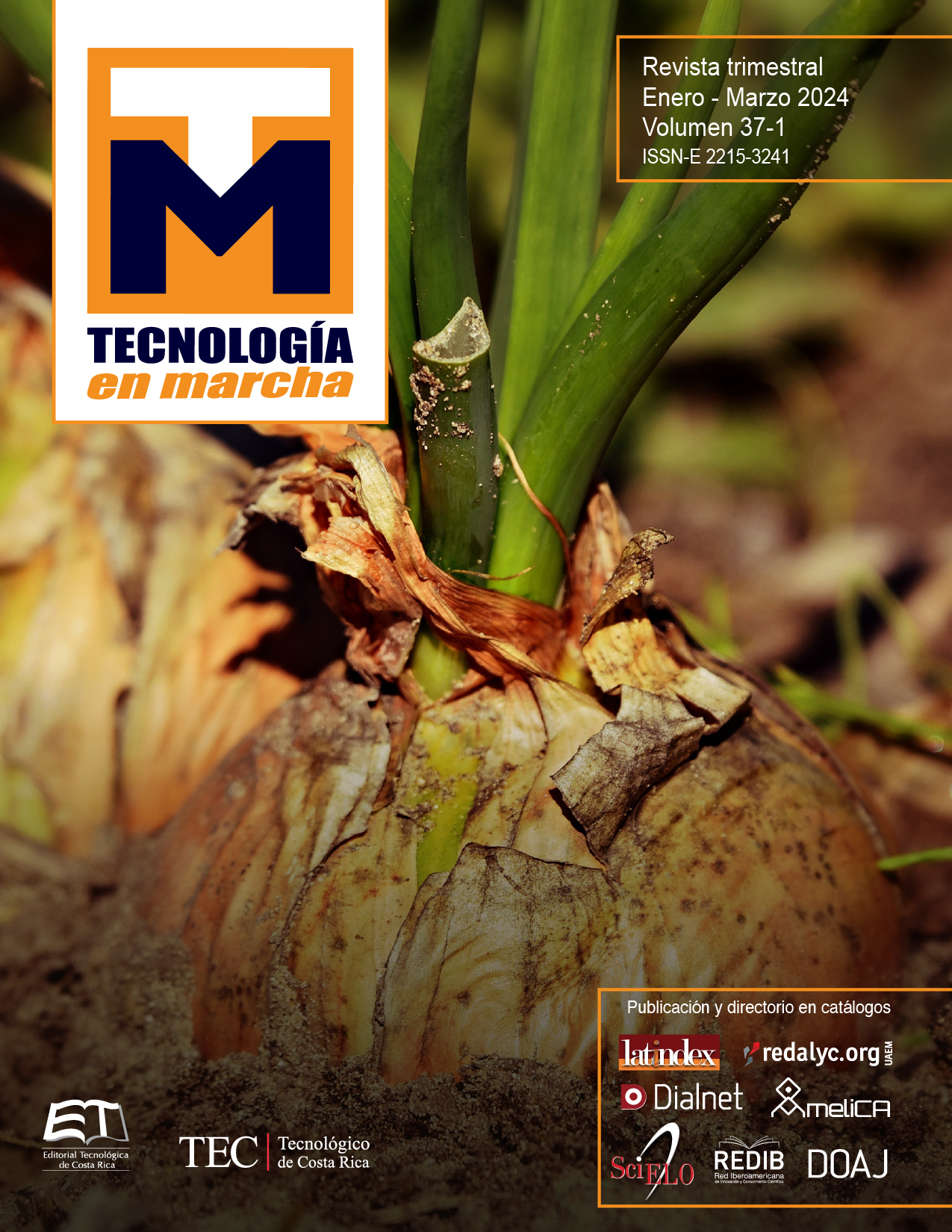Evaluation of TiO2 sensitized with cobalt trimer dyes as photocatalyst for water-splitting hydrogen production
Main Article Content
Abstract
In this research, sensitized TiO2 photocatalysts were synthesized based on the functionalization of their surface with organic molecules (glycine and aminocaproic acid) and a cobalt trimer in its molecular form [Co3(dpa)4Cl2], (dpa = 2,2'-dipyridylamine), using two different heating methods (reflux and microwave) to carry out the anchoring reactions. The capacities of the photocatalysts for producing hydrogen from the water-splitting reaction were evaluated using a medium-pressure Hg lamp (125 W) and methanol as a sacrificial agent. Also, CuO-TiO2 and CoO-TiO2 photocatalysts were synthesized and evaluated for comparison purposes. The photocatalyst that presented the best performance was TiO2 sensitized with the cobalt trimer, using glycine as an anchoring molecule, and prepared with microwave heating; this photocatalyst generated hydrogen at an average rate of 1887 mmol g-1 h-1. It was observed that the chain length of the anchoring molecule affects the photocatalytic activity, as the chain length increases, the production of hydrogen decreases. Last, microwave heating produced the photocatalyst with the best performance on hydrogen generation.
Article Details

This work is licensed under a Creative Commons Attribution-NonCommercial-NoDerivatives 4.0 International License.
Los autores conservan los derechos de autor y ceden a la revista el derecho de la primera publicación y pueda editarlo, reproducirlo, distribuirlo, exhibirlo y comunicarlo en el país y en el extranjero mediante medios impresos y electrónicos. Asimismo, asumen el compromiso sobre cualquier litigio o reclamación relacionada con derechos de propiedad intelectual, exonerando de responsabilidad a la Editorial Tecnológica de Costa Rica. Además, se establece que los autores pueden realizar otros acuerdos contractuales independientes y adicionales para la distribución no exclusiva de la versión del artículo publicado en esta revista (p. ej., incluirlo en un repositorio institucional o publicarlo en un libro) siempre que indiquen claramente que el trabajo se publicó por primera vez en esta revista.
References
A. Ochs, A. Dolezal, A. Majano, R. Palencia. (2013). The way forward for renewable energy in Central America, Worldwatch Institute. [En línea] Disponible en: https://cdkn.org/wp-content/uploads/2013/04/The-Way-Forward-for-Renewable-Energy-in-Central-America_english_FINAL.pdf
World Energy Council. (2019). New Hydrogen Economy: Hope or Hype?, World Energy Council. [En línea] Disponible en: https://www.worldenergy.org/assets/downloads/WEInsights-Brief-New-Hydrogen-economy-Hype-or-Hope-ExecSum.pdf.
S. Dutta. “Review on Solar Hydrogen: Its Prospects and Limitations”, Energy & Fuels, 35, pp. 11613–11639, 2021. https://doi.org/10.1021/acs.energyfuels.1c00823
S. Z. Baykara. “Hydrogen: A brief overview on its sources, production and environmental impact”, International Journal of Hydrogen Energy, 43, pp. 10605–10614, 2018. https://doi.org/10.1016/j.ijhydene.2018.02.022
A. A. Ismail, D. W. Bahnemann, “Photochemical splitting of water for hydrogen production by photocatalysis: A review”, Solar Energy Materials and Solar Cells, 128, pp. 85-101, 2014. https://doi.org/10.1016/j.solmat.2014.04.037
L. Sun, L. Han, J. Huang, X. Luo, X. Li, “Single-atom catalysts for photocatalytic hydrogen evolution: A review”, International Journal of Hydrogen Energy, 47, 40, pp. 17583-17599, 2022. https://doi.org/10.1016/j.ijhydene.2022.03.259
R. Ameta, M. S. Solanki, S. Benjamin, S. C. Ameta, “Photocatalysis” in Advanced Oxidation Processes for Waste Water Treatment, Academic Press, 2018, ch. 6, pp. 135–175. https://doi.org/10.1016/b978-0-12-810499-6.00006-1
T. Hisatomi, J. Kubota, K. Domen, “Recent advances in semiconductors for photocatalytic and photoelectrochemical water splitting”, Chem. Soc. Rev., 43, pp. 7520–7535, 2014. https://doi.org/10.1039/c3cs60378d
M. Nasirian, Y. P. Lin, C. F. Bustillo-Lecompte, M. Mehrvar, “Enhancement of photocatalytic activity of titanium dioxide using non-metal doping methods under visible light: a review”, International Journal of Environmental Science and Technology, 15, pp. 2009–2032, 2017. https://doi.org/10.1007/s13762-017-1618-2
M. Ismael, “Latest progress on the key operating parameters affecting the photocatalytic activity of TiO2-based photocatalysts for hydrogen fuel production: A comprehensive review”, Fuel, 303, pp. 121207, 2021. https://doi.org/10.1016/j.fuel.2021.121207
S. Xu, D. D. Sun. “Significant improvement of photocatalytic hydrogen generation rate over TiO2 with deposited CuO”, International Journal of Hydrogen Energy, 34, pp. 6096–6104, 2009. https://doi.org/10.1016/j.ijhydene.2009.05.119
J. Yu, Y. Hai, M. Jaroniec, “Photocatalytic hydrogen production over CuO-modified titania”, Journal of Colloid and Interface Science, 357, pp. 223–228, 2011. https://doi.org/10.1016/j.jcis.2011.01.101
Y. Liu, Z. Wang, W. Huang, “Influences of TiO2 phase structures on the structures and photocatalytic hydrogen production of CuOx/TiO2 photocatalysts”, Applied Surface Science, 389, pp. 760-767, 2016. https://doi.org/10.1016/j.apsusc.2016.07.173
Y. Liu, Z. Ye, D. Li, M. Wang, Y. Zhang, W. Huang, “Tuning CuOx-TiO2 interaction and photocatalytic hydrogen production of CuOx/TiO2 photocatalysts via TiO2 morphology engineering”, Applied Surface Science, 473, pp. 500–510, 2019. https://doi.org/10.1016/j.apsusc.2018.12.177
C. Rivera, “Funcionalización de dióxido de titanio nanoparticulado con diferentes moléculas orgánicas bifuncionales y trímeros de compuestos de transición para la obtención de nuevos materiales”, Tesis de Maestría, Escuela de Química, Univ. de Costa Rica, San José, Costa Rica, 2012.
T. Sreethawong, T. Puangpetch, T. Chavadej, T. Yoshikawa, “Quantifying influence of operational parameters on photocatalytic H2 evolution over Pt-loaded nanocrystalline mesoporous TiO2 prepared by single-step sol–gel process with surfactant template”, Journal of Power Sources, 165, pp. 861–869, 2007. https://doi.org/10.1016/j.jpowsour.2006.12.050
Q. Xiao, J. Zhang, C. Xiao, X. Tan, “Photocatalytic degradation of methylene blue over Co3O4/Bi2WO6 composite under visible light irradiation”, Catalysis Communications, 9, 6, pp. 1247-1253, 2008. https://doi.org/10.1016/j.catcom.2007.11.011
C. Han, L. Ge, C. Chen, Y. Li, X. Xiao, Y. Zhang, L. Guo, “Novel visible light induced Co3O4-g-C3N4 heterojunction photocatalysts for efficient degradation of methyl orange”, Applied Catalysis B: Environmental, 147, pp. 546–553, 2014. https://doi.org/10.1016/j.apcatb.2013.09.038

